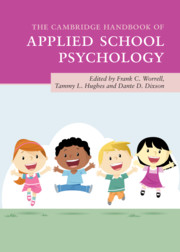Book contents
- The Cambridge Handbook of Applied School Psychology
- The Cambridge Handbook of Applied School Psychology
- Copyright page
- Contents
- Contributors
- Contributor Biographies
- Acknowledgments
- 1 Broadening the Focus of School Psychology Practice
- Part I Individual-Level Academic Interventions
- Part II Teacher- and System-Level Interventions
- Part III Interventions from Educational and Social/Personality Psychology
- Part IV Behavioral and Social-Emotional Interventions
- 19 Internalizing Problems and Disorders of Childhood
- 20 Adolescent Suicidal Behavior in Schools: What to Know and What to Do
- 21 Emotional Disturbance versus Social Maladjustment
- 22 Autism Spectrum Disorder and Illegal Acts
- 23 Effective Bullying Prevention and Intervention Strategies for School Professionals
- 24 Principles of Prevention and Intervention to Close Discipline Gaps in Schools
- 25 Social and Emotional Learning in Schools
- Part V Health and Pediatric Interventions
- Part VI Family Connections and Life Transitions
- Part VII Special Populations
- Part VIII Conclusion
- Index
- References
20 - Adolescent Suicidal Behavior in Schools: What to Know and What to Do
from Part IV - Behavioral and Social-Emotional Interventions
Published online by Cambridge University Press: 18 September 2020
- The Cambridge Handbook of Applied School Psychology
- The Cambridge Handbook of Applied School Psychology
- Copyright page
- Contents
- Contributors
- Contributor Biographies
- Acknowledgments
- 1 Broadening the Focus of School Psychology Practice
- Part I Individual-Level Academic Interventions
- Part II Teacher- and System-Level Interventions
- Part III Interventions from Educational and Social/Personality Psychology
- Part IV Behavioral and Social-Emotional Interventions
- 19 Internalizing Problems and Disorders of Childhood
- 20 Adolescent Suicidal Behavior in Schools: What to Know and What to Do
- 21 Emotional Disturbance versus Social Maladjustment
- 22 Autism Spectrum Disorder and Illegal Acts
- 23 Effective Bullying Prevention and Intervention Strategies for School Professionals
- 24 Principles of Prevention and Intervention to Close Discipline Gaps in Schools
- 25 Social and Emotional Learning in Schools
- Part V Health and Pediatric Interventions
- Part VI Family Connections and Life Transitions
- Part VII Special Populations
- Part VIII Conclusion
- Index
- References
Summary
School psychologists play a vital role in the mental health and well-being of students and are often tasked with establishing the assessment and intervention plans for reducing the severity of mental health difficulties, including suicidal behavior. With suicide the second-leading cause of death for middle and high school students, school psychologists need to be familiar with what their role is in recommending and providing suicide prevention and intervention programs within a multitiered systems of support (MTSS) framework. This chapter provides an overview of the problem of adolescent suicidal behavior (“what to know”), while also providing specific recommendations (“what to do”) for suicide prevention/intervention programs within each tier of the MTSS. Finally, this chapter includes specific guidelines for implementing “suicide postvention” (after a death due to suicide) procedures, in hopes of reducing the likelihood of another death due to suicide.
Keywords
- Type
- Chapter
- Information
- The Cambridge Handbook of Applied School Psychology , pp. 335 - 352Publisher: Cambridge University PressPrint publication year: 2020

